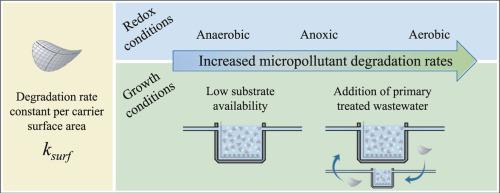Journal of Hazardous Materials ( IF 13.6 ) Pub Date : 2021-02-25 , DOI: 10.1016/j.jhazmat.2021.125535 Ellen Edefell , Per Falås , Elena Torresi , Marinette Hagman , Michael Cimbritz , Kai Bester , Magnus Christensson

|
A novel process configuration was designed to increase biofilm growth in tertiary moving bed biofilm reactors (MBBRs) by providing additional substrate from primary treated wastewater in a sidestream reactor under different redox conditions in order to improve micropollutant removal in MBBRs with low substrate availability. This novel recirculating MBBR was operated on pilot scale for 13 months, and a systematic increase was seen in the biomass concentration and the micropollutant degradation rates, compared to a tertiary MBBR without additional substrate. The degradation rates per unit carrier surface area increased in the order of ten times, and for certain micropollutants, such as atenolol, metoprolol, trimethoprim and roxithromycin, the degradation rates increased 20–60 times. Aerobic conditions were critical for maintaining high micropollutant degradation rates. With innovative MBBR configurations it may be possible to improve the biological degradation of organic micropollutants in wastewater. It is suggested that degradation rates be normalized to the carrier surface area, in favor of the biomass concentration, as this reflects the diffusion limitations of oxygen, and will facilitate the comparison of different biofilm systems.
中文翻译:

通过控制生长和氧化还原条件促进三级移动床生物膜反应器中有机微量污染物的降解
通过在侧流反应器中在不同的氧化还原条件下从一级处理废水中提供额外的底物,设计了一种新的工艺配置,以提高三级移动床生物膜反应器(MBBR)中的生物膜生长,从而提高了底物利用率低的MBBR中微污染物的去除率。这种新型的循环MBBR在中试规模上运行了13个月,与没有其他底物的叔MBBR相比,生物量浓度和微污染物降解速率得到了系统性的提高。每单位载体表面积的降解率增加了十倍左右,对于某些微污染物,如阿替洛尔,美托洛尔,甲氧苄啶和罗红霉素,降解率增加了20-60倍。有氧条件对于维持较高的微污染物降解率至关重要。使用创新的MBBR配置,可能会改善废水中有机微污染物的生物降解。建议将降解速率归一化到载体表面积,有利于生物质浓度,因为这反映了氧气的扩散限制,并且将有助于比较不同的生物膜系统。


























 京公网安备 11010802027423号
京公网安备 11010802027423号